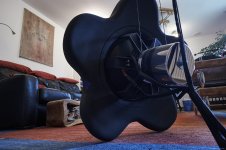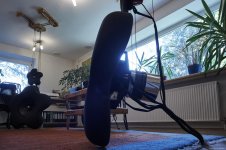I did the opposite, car coaxial drivers have a hole through the magnet for mounting the tweeter, I used this hole to thread some studding through so I could clamp a lump ( a couple of kg ) solidly to the magnet. I used the drivers as tweeters like this ( just as a experiment ) and the sounded " hard ", in a good way. I both agree and disagree with you on floating drivers improving transients, I'm thinking that floating drivers would reduce the efficiency of the drive, reducing transients, however the much reduced cabinet vibration would reduce warm muddyness, preserving the remaining transiesnts so much so, you'd have better transients than conventional speakers.
This is the test that is making me wonder about the transient response http://www.linkwitzlab.com/Driver Decoupling.doc
Hi,
The free-swinging bass driver on strings is the most extreme case of de-coupling not only from the baffle, but from anything else. The big advantage is that there isn´t much left to activate resonances from, the disadvantage is a slight loss quantified by the ratio of the total mass against Mms.
There have been lot´s of discussions and theories on this forum, just search for free-swinging and have a look at Michael´s implementations and explanations (which, to be honest, I wouldn´t judge as right or wrong, due to lack of my own knowledge...).
I may additionally offer my own experiences with decoupled, even swinging drivers and found that bettering the mass ratio indeed leads to advantages in music recreation, although I found the differences too small to be reliably measured. But it lead me to add a "counterweight" to my free-swinging 18" bass drivers, bettering the ratio from app. 1:90 to 1:200.
In a box design, I use a 5" FR driver softly "clamped" between baffle and brace, ratio is nearly 1:400, no problems detectable (at least not for me, YMMV of course...).
All the best
Mattes
The free-swinging bass driver on strings is the most extreme case of de-coupling not only from the baffle, but from anything else. The big advantage is that there isn´t much left to activate resonances from, the disadvantage is a slight loss quantified by the ratio of the total mass against Mms.
There have been lot´s of discussions and theories on this forum, just search for free-swinging and have a look at Michael´s implementations and explanations (which, to be honest, I wouldn´t judge as right or wrong, due to lack of my own knowledge...).
I may additionally offer my own experiences with decoupled, even swinging drivers and found that bettering the mass ratio indeed leads to advantages in music recreation, although I found the differences too small to be reliably measured. But it lead me to add a "counterweight" to my free-swinging 18" bass drivers, bettering the ratio from app. 1:90 to 1:200.
In a box design, I use a 5" FR driver softly "clamped" between baffle and brace, ratio is nearly 1:400, no problems detectable (at least not for me, YMMV of course...).
All the best
Mattes
Attachments
My experience with driver decoupling has been negative. It helps reduce cabinet vibrational mode excitation, but also resulted in a less clear sound for me. It's only speculation, but I suspect that energy is then trapped within the basket structure, long ringing, with no clean mechanical energy transfer impedance path.
Resonance of the basket is an issue. Issues in speaker design - 2 Magnet mounting helps Issues in speaker design - 2
My experience with driver decoupling has been negative. It helps reduce cabinet vibrational mode excitation, but also resulted in a less clear sound for me. It's only speculation, but I suspect that energy is then trapped within the basket structure, long ringing, with no clean mechanical energy transfer impedance path.
Can you be sure it’s not pleasing (but ultimately inaccurate) resonant modes in the cabinet contributing to the sound?
My experience with driver decoupling has been negative. It helps reduce cabinet vibrational mode excitation, but also resulted in a less clear sound for me. It's only speculation, but I suspect that energy is then trapped within the basket structure, long ringing, with no clean mechanical energy transfer impedance path.
Resonance of the basket is an issue. Issues in speaker design - 2 Magnet mounting helps Issues in speaker design - 2
Resonance of the basket is a driver design issue, not a decoupling issue. Look for a driver with a non-resonant, cast basket.
If you must use a driver with a resonant basket, you can attach a ring of material to the frame that is maybe 2" wide. Then you can make the cutout in the cabinet fit the ring instead of the driver. I had to do this recently with the new 12" "open baffle" woofer from SB Audience. It has a stamped steel frame and it does ring when tapped with a finger. But if I mounted the driver in a low clearance (around the frame) ring of 0.75" thick MDF the contact with the frame completely changed (dampened) the ringing to the point that it is no longer an issue. To make the ring I first made a larger cutout in the baffle about 4" wider than the driver frame OD using a router and a jig. Then into the round piece that was created from that cut, I cut the driver mounting hole using the same center pivot point. Super easy. The gap is the same width of my router bit.
I will hang the driver-and-ring from the rest of the baffle via wires but will not bother to seal up the gap because it is an open baffle system.
Yes, as SL says in the linked article (to save people reading it 🙂) Thanks for the suggestions on dealing with it.Resonance of the basket is a driver design issue, not a decoupling issue. Look for a driver with a non-resonant, cast basket.
Here's an option. Extremely Soft | Silicone Rubber Gel | Shore Hardness 0035 | Smooth-On Just spread it like peanut butter and cut it to size.Thanks, Arthur - good to read. While they can go off and ultimately procure custom cast shape gel elastomers, I have to make do with the choice of whatever properties I can wring out of a few different yoga and other floor mats.
I wonder if anyone has tried attaching a heavy steel/lead cap on the magnet with a gel like the one above to function similar to the harmonic balancer on a car's crank shaft. I can see it working very well when tuned together with the compliance of the gel.
I wonder if anyone has tried attaching a heavy steel/lead cap on the magnet with a gel like the one above to function similar to the harmonic balancer on a car's crank shaft. I can see it working very well when tuned together with the compliance of the gel.
That kind of mechanical system can be tuned to resonate (adsorb) energy, but only at one frequency. So it probably wouldn't be all that useful.
Adding lots of mass to the back of the magnet would be useful (as another poster mentioned) to increase the ratio of cone mass to the total mass (when applied to a decoupled system). I have sometimes thought of a sand-filled "cone" the same diameter as the magnet, for example. If there is a pole vent, that has to be kept open.
Last edited:
Why just one frequency? It is incorporated on the crank shaft for the very reason of a constantly variable rpm. Otherwise it would not be needed
What about torque? we could calculate a relationship between the internal combustion engine vs. a speaker?
It probably doesn't influence the final sound but it would be entertaining ........
I have the feeling that there was a lot of toasts this end of the year, maybe it would be better to wait a few days.
"Looking at the tree closely prevents you from seeing the forest"
It probably doesn't influence the final sound but it would be entertaining ........
I have the feeling that there was a lot of toasts this end of the year, maybe it would be better to wait a few days.
"Looking at the tree closely prevents you from seeing the forest"
Why just one frequency? It is incorporated on the crank shaft for the very reason of a constantly variable rpm. Otherwise it would not be needed
See:
Tuned mass damper - Wikipedia
Look at the frequency response plot on the left side of the page. It's not as effective as you think... it actually makes the vibration worse for some frequencies but does reduce the peak amount of motion around one frequency.
Last edited:
Torque has nothing to do with why the damper is needed. it's there to absorb vibration of varying frequency.
"comparatively light weight component" is the key here. If the driver weighs 20lbs, put a 20lb damper on it. We don't care how heavy it needs to be now do we?😀See:
Tuned mass damper - Wikipedia
Look at the frequency response plot on the left side of the page. It's not as effective as you think... it actually makes the vibration worse for some frequencies but does reduce the peak amount of motion around one frequency.
Here is a good read about driver decoupling in the development of the B&W 800D
Thanx Arthur.
So decoupling is effective if it is correctly applied, the big danger being that the resonance of the magnet on the decoupling spring may fall within the pass band. If that is the case, there will
be a peak and a dip in the response the size of which depends on the decoupling spring losses. Of course, the larger the losses the less effective the decoupling will be… It is vital to ensure that the fundamental spring /mass resonance of any reliable decoupling scheme is below the operating frequency range of the speaker
drive unit.
The B&W study suggests that this is much more nuanced than any of us have expressed so far. And from the bits quoted probably very difficult to implement on the FR drivers i mostly use. And difficut with a bass driver. That also makes it difficult to use on a woofer.
One of my mentors did take the isolation idea to levels at least as advanced as what B&W presents… he used real springs under his tweter pod to isolate them from th ebox the bass driver was in.
dave
Adding lots of mass to the back of the magnet would be useful
Essentially what i have been doing by being very careful that the entire mass of the box is attached to the driver (not just the magnet).
(Potentail) box resonances need to be high in frequency and high in Q so that the energy from the music is very unlikely to ever excite them.
And Charlie, just like any box material, there is no such thing as a non-resonant basket, and a cast basket is not a guarantee of low resonance (or resonances placed where they don’t matter), i have had a few thru here that were not good. The best baskets i have seen are some sort of well-engineered plastic.
dave
The need for a lower than pass band resonance was in the Linkwitz Lab article I posted a couple of days ago.The B&W study suggests that this is much more nuanced than any of us have expressed so far.
I question the requirement for high Q, I presume you think this is better because it "narrows" the resonant frequency band?(Potentail) box resonances need to be high in frequency and high in Q so that the energy from the music is very unlikely to ever excite them.
- Home
- Loudspeakers
- Full Range
- Softly coupling a driver to the cabinet

